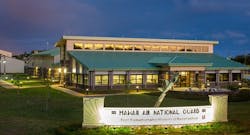BWR Innovations Chosen to Deliver PEM Fuel Cells for Hawaii Base Microgrid H2 Integration
North Dakota-based energy monitoring and fuel cell firm BWR Innovations has been contracted to deliver integration capabilities for a future hydrogen fuel cell microgrid project at a legendary military base in Hawaii.
Global Connective Center LLC granted BWR Innovations the two-year subcontract as part of an agreement with the Air Force Research Laboratory (AFRL). The Hydrogen Fuel Cell Microgrid (H2MG) project is a research, development, testing and evaluation effort to demonstrate feasibility and performance of the solar-hydrogen (H2) storage and off-take system.
The goal is to develop and support island-able microgrids which can be disconnected, operate and maintain power in the event of an overall grid outage. The H2MG project will expand on the current capabilities of the 1.5-MW Pacific Energy Assurance Renewables Laboratory solar photovoltaic microgrid which was started eight years ago at the Joint Base Pearl Harbor Hickam in Oahu.
“This AFRL project is an important demonstration of the BWR hydrogen fuel cell integration technology. We expect that the results from this project will reflect the importance of hydrogen as a critical component in the clean energy microgrid solutions,” Joel Jorgenson, president and CEO of BWR, said in a statement.
BWR Innovations will deliver a 1-MW electrolyzer, which splits water into its H2 and oxygen components, a compressor, 600 kilograms of hydrogen storage capacity, 600 kW of proton exchange membrane (PEM) fuel cells and software technology to control and integrate it into the existing microgrid at Pearl Harbor-Hickam.
Fuel cells take a resource, such as hydrogen or natural gas, and use a electrochemical process to convert the fuel to electrical energy. To be considered truly green hydrogen, the H2 should be created from electrolyzers powered by carbon-free resources such as solar, wind, battery storage or nuclear. Hydrogen does not contain carbon in its chain and thus does not emit carbon dioxide when combusted or consumed.
The project is supported by a stakeholder base that includes the Indo-Pacific Command, the National Guard Bureau, the Hawaii Air National Guard and the Naval Facilities Engineering Systems Command. Microgrids increasingly are becoming part of future energy planning for the U.S. Department of Defense and respective military branches.
Read some of our recent Microgrid Knowledge stories on military microgrids
US Army Improves Resiliency at Fort Cavazos
Noresco Lands 10-MW Microgrid Project at Air Force Base in Japan
MCB Camp Lejeune Chooses Duke Energy to Build $22M Microgrid
About the Author
Rod Walton, Microgrid Knowledge Managing Editor
Managing Editor
For Microgrid Knowledge editorial inquiries, please contact Managing Editor Rod Walton at [email protected].
I’ve spent the last 15 years covering the energy industry as a newspaper and trade journalist. I was an energy writer and business editor at the Tulsa World before moving to business-to-business media at PennWell Publishing, which later became Clarion Events, where I covered the electric power industry. I joined Endeavor Business Media in November 2021 to help launch EnergyTech, one of the company’s newest media brands. I joined Microgrid Knowledge in July 2023.
I earned my Bachelors degree in journalism from the University of Oklahoma. My career stops include the Moore American, Bartlesville Examiner-Enterprise, Wagoner Tribune and Tulsa World, all in Oklahoma . I have been married to Laura for the past 33-plus years and we have four children and one adorable granddaughter. We want the energy transition to make their lives better in the future.
Microgrid Knowledge and EnergyTech are focused on the mission critical and large-scale energy users and their sustainability and resiliency goals. These include the commercial and industrial sectors, as well as the military, universities, data centers and microgrids. The C&I sectors together account for close to 30 percent of greenhouse gas emissions in the U.S.
Many large-scale energy users such as Fortune 500 companies, and mission-critical users such as military bases, universities, healthcare facilities, public safety and data centers, shifting their energy priorities to reach net-zero carbon goals within the coming decades. These include plans for renewable energy power purchase agreements, but also on-site resiliency projects such as microgrids, combined heat and power, rooftop solar, energy storage, digitalization and building efficiency upgrades.

